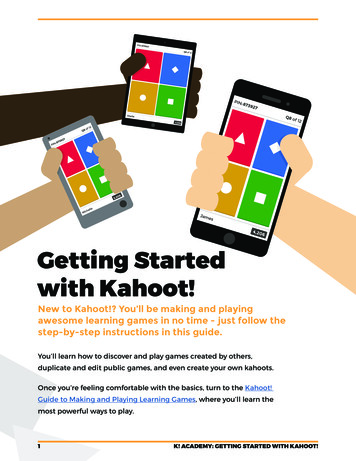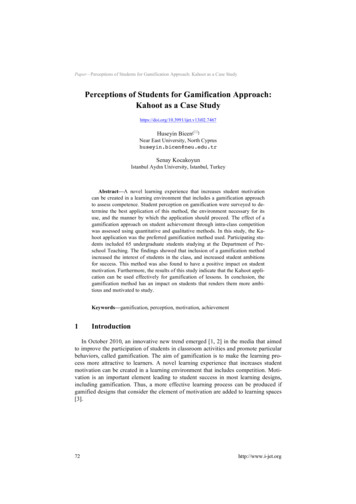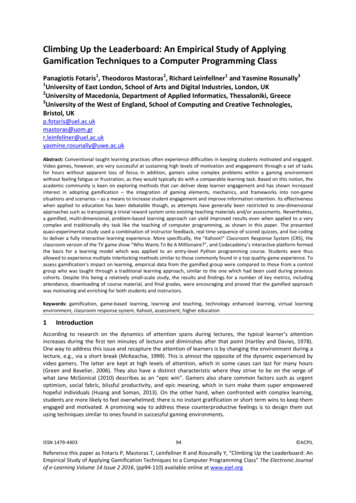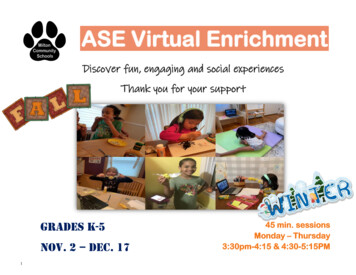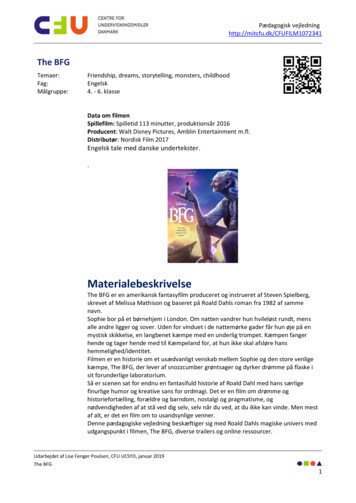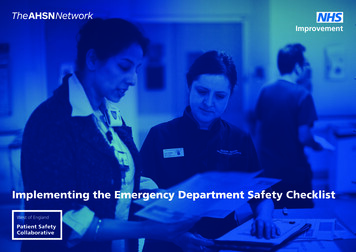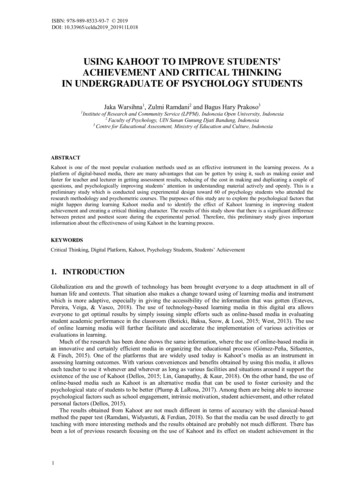
Transcription
ISBN: 978-989-8533-93-7 2019DOI: 10.33965/celda2019 201911L018USING KAHOOT TO IMPROVE STUDENTS’ACHIEVEMENT AND CRITICAL THINKINGIN UNDERGRADUATE OF PSYCHOLOGY STUDENTS1Jaka Warsihna1, Zulmi Ramdani2 and Bagus Hary Prakoso3Institute of Research and Community Service (LPPM), Indonesia Open University, Indonesia2Faculty of Psychology, UIN Sunan Gunung Djati Bandung, Indonesia3Centre for Educational Assessment, Ministry of Education and Culture, IndonesiaABSTRACTKahoot is one of the most popular evaluation methods used as an effective instrument in the learning process. As aplatform of digital-based media, there are many advantages that can be gotten by using it, such as making easier andfaster for teacher and lecturer in getting assessment results, reducing of the cost in making and duplicating a couple ofquestions, and psychologically improving students’ attention in understanding material actively and openly. This is apreliminary study which is conducted using experimental design toward 60 of psychology students who attended theresearch methodology and psychometric courses. The purposes of this study are to explore the psychological factors thatmight happen during learning Kahoot media and to identify the effect of Kahoot learning in improving studentachievement and creating a critical thinking character. The results of this study show that there is a significant differencebetween pretest and posttest score during the experimental period. Therefore, this preliminary study gives importantinformation about the effectiveness of using Kahoot in the learning process.KEYWORDSCritical Thinking, Digital Platform, Kahoot, Psychology Students, Students’ Achievement1. INTRODUCTIONGlobalization era and the growth of technology has been brought everyone to a deep attachment in all ofhuman life and contexts. That situation also makes a change toward using of learning media and instrumentwhich is more adaptive, especially in giving the accessibility of the information that was gotten (Esteves,Pereira, Veiga, & Vasco, 2018). The use of technology-based learning media in this digital era allowseveryone to get optimal results by simply issuing simple efforts such as online-based media in evaluatingstudent academic performance in the classroom (Boticki, Baksa, Seow, & Looi, 2015; West, 2013). The useof online learning media will further facilitate and accelerate the implementation of various activities orevaluations in learning.Much of the research has been done shows the same information, where the use of online-based media inan innovative and certainly efficient media in organizing the educational process (Gómez-Peña, Sifuentes,& Finch, 2015). One of the platforms that are widely used today is Kahoot’s media as an instrument inassessing learning outcomes. With various conveniences and benefits obtained by using this media, it allowseach teacher to use it whenever and wherever as long as various facilities and situations around it support theexistence of the use of Kahoot (Dellos, 2015; Lin, Ganapathy, & Kaur, 2018). On the other hand, the use ofonline-based media such as Kahoot is an alternative media that can be used to foster curiosity and thepsychological state of students to be better (Plump & LaRosa, 2017). Among them are being able to increasepsychological factors such as school engagement, intrinsic motivation, student achievement, and other relatedpersonal factors (Dellos, 2015).The results obtained from Kahoot are not much different in terms of accuracy with the classical-basedmethod the paper test (Ramdani, Widyastuti, & Ferdian, 2018). So that the media can be used directly to getteaching with more interesting methods and the results obtained are probably not much different. There hasbeen a lot of previous research focusing on the use of Kahoot and its effect on student achievement in the1
16th International Conference on Cognition and Exploratory Learning in Digital Age (CELDA 2019)classroom or in order to improve their various positive personal attributes in school (Dellos, 2015; Ismail& Mohammad, 2017; Lin et al., 2018; Yapıcı & Karakoyun, 2017). The use of Kahoot allows students to getmore interesting learning method so that they not only increase their awareness of the importance of thematerial but also increase their efforts to actively learn and enjoy each learning activity. However, not manystudies have tried to explore the use of Kahoot’s media toward students’ critical thinking attributes inschools, even though these psychological attributes are very important as part of higher-order thinkingstudents and also how they continue their plans and lives in society (Amrullah, Tae, Ramdani, Irawan,& Prakoso, 2018).Critical thinking is one of the important abilities that students must have in their learning process(Facione et al., 1995). One of these critical thinking skills can be developed using technology-based mediasuch as Kahoot. The existing scheme in using Kahoot allows each student to prepare themselves as well aspossible to determine the most appropriate choice they will face in the matter (Lin, Ganapathy, & Kaur,2018). As a media with accessibility that is easily accessible to everyone, Kahoot can be one of the onlinemedia which then requires its users to think carefully with the answers they will choose because they arefaced with limited time and accuracy in choosing answers (Lin et al., 2018). There are not many studies thattry to see Kahoot’s use of increasing critical thinking, especially in psychology learning. Whereaspsychological material has a lot to do with concepts and theories that must be mastered specifically (Ramdaniet al., 2018). So the use of online media such as Kahoot can make it easier to memorize and increasestudents’ curiosity about deeper psychological material (Plump & LaRosa, 2017). This study tries to see theeffect of Kahoot’s media usage on improving student achievement and their critical thinking processes andhow these factors interact in creating a better quality of education.2. THEORETICAL FRAMEWORK2.1 Kahoot as Digital PlatformKahoot is an online media platform that used to evaluate the results of the learning process. It provides manyinteresting and useful feature, especially in doing an activity such as quiz, survey, and group discussion aboutlearning (Dellos, 2015). The use of this media is very easy because the teacher practically only movesvarious questions and related cases that must be completed by students within a certain period of time (Lin etal., 2018). The implementation of activities using Kahoot is certainly very efficient to use in the classroombecause the examination can be done together. This platform also provides an attractive display because itcontains a collection of visualizations and music that are useful for stimulating not only the student’s kineticbody but also to increase their curiosity about the material to be tested (Pede, 2017). One of the challengesthat might be faced is related to external factors such as noise and the air temperature around it. In addition,the effectiveness of Kahoot’s use can run optimally if it is equipped and supported by adequate of internetfacilities.Figure 1. Kahoot platform145
ISBN: 978-989-8533-93-7 20192.2 Students’ AchievementLearning achievement is often the main indicator in seeing whether the learning process runs optimally ornot. This learning achievement is manifested in various forms and activities all of which stem from the abilityof students to understand and learn a material (Dunn & Kennedy, 2019). As one of the important factors inthe learning process, learning achievement is highly related and determined by other factors that only appearpersonally, but also the influence of other extrinsic factors (An & Carr, 2017). Learning achievementdetermines whether can graduate at the next higher stage. The optimal or not a person’s learning outcomesdepend on how he prepares himself to get the best results. This also determined by the personal students whointeract with the environment in which they grow and develop (Liao, Chen, & Shih, 2019). The use ofappropriate media will result in more active and collaborative learning, especially if the learning is designedwith technological progress and adapted to the dynamics that occur in the classroom.2.3 Critical ThinkingCritical thinking is an intellectual and structural process which is actively related to the ability inconceptualizing, applying, analyzing, constructing, and evaluating information which is gotten through theprocess of observation, experience, reflection, reason, and communication (Boa, Wattanatorn, & Tagong,2018). According to Sasson, Yehuda and Malkinson (2018), critical thinking is an important part of humanlife in understanding the complexity of the phenomenon. Critical thinking emphasis the students feel on theproblem, having a strong and a clear perspective about the future life, full of consideration in doing tasks, andgood at problem-solving and making a decision (Facione, Facione, Sanchez, & Gainen, 1995). Thispsychological aspect is closely related to various other aspects of life, such as in filtering informationreceived by individuals, clarifying conflicts that arise, solving a difficult problem, even correcting a decisionthat might be wrong.Critical thinking is important to be trained in daily life, especially when individuals get informationrelated to uncertain rumours and issues (Sasson et al., 2018). The theoretical framework of the criticalthinking starts from The Delphi Panel (Facione, 1990) by doing identification toward the key elements thatmight happen in the reasoning process while the critical thinking disposition refers to the human’ tendency indealing with the problem which is based on logical reasoning (Facione et al., 1995). Critical thinkingencompasses various aspects that are not only in the form of the critical nature that is created within but alsoincludes a set of abilities that are trained and developed to deal with various difficult and confusingsituations. With critical thinking, students are expected to be able to develop themselves better in accordancewith the demands of the environment.2.4 Kahoot, Students’ Achievement and Critical ThinkingThe learning process which is based on critical thinking is needed, especially in getting the goals of learning(Amrullah et al., 2018). Students who have higher critical thinking criteria tend to have better academicperformance, as well as those with average and lower critical thinking (Fong, Kim, Davis, Hoang, & Kim,2017). The ability to analyze and interpret is the part of the planning process while the ability to evaluate,inference, and to make deduction are the part of making a decision process (D’Alessio, Avolio, & Charles,2019). Critical thinking disposition is also able to increase the effectiveness of student learning in theclassroom (Fung, 2017).According to Pitt et al., (2015), critical thinking is useful for preparing everything needed by students inthe learning process. Other research shows that there is a significant result between score, which is gottenfrom students with their academic performance (Pitt et al., 2015). Students’ achievement and critical thinkingare two psychological aspects which have been proven to get a lot of improvement when processed usingonline-based media (Esteves et al., 2018). The use of online-based media such as Kahoot allows students toprepare themselves as well as possible in the face of an exam that will be given (Licorish, Owen, & Daniel,2017). This continues to their ability to prepare themselves, put themselves in the right situation, choose thebest choice according to what they understand and try themselves to be prepared and always active in dealingwith various severe social and environmental stimuli (Plump & LaRosa, 2017).146
16th International Conference on Cognition and Exploratory Learning in Digital Age (CELDA 2019)3. METHODThis preliminary study is conducted using experimental pretest-posttest one group only design (Stephens,Matzke, & Hayes, 2018; Weger & Wagemann, 2015). The aim of this method is to see the effect of usingKahoot as an evaluation method based digital which is hopeful to improve students’ achievement and theircritical thinking dispositions. Samples were chosen by using a purposive sampling method where aresearcher can select the subjects based on the criteria which were decided before the time sampling (Azwar,2007, 2016). Samples who are in listed as a student in research methodology and psychometric courses inFebruary until June 2019 period. All subjects who were participating in the research got the informedconsents as a form of their willingness to follow the research.The experimental study was done for 4 weeks, where the first week, subjects will be getting the materialaccording to the courses guideline. The second week, they are given a set of multiple questions with using apaper-based test examination. In the third week, they get knowledge about how to use Kahoot as anevaluation method in their learning process and in the last week, subjects were given the same and parallel aset of questions using Kahoot media. After that, they also are given an additional questionnaire that measurescritical thinking disposition as a form of validated criteria of learning achievement. Further qualitativeanalysis was carried out to get students’ personal understanding of whether Kahoot’s use was able to improvecritical thinking indicators experienced by students before and after learning using Kahoot.This preliminary study uses two measurements which were made by the researcher that measure students’learning achievement and critical thinking disposition. The learning achievement measurement tool is madeby the method of preparing a cognitive test according to the material to be tested (Ramdani, 2018). Theresults are two forms of a set of questions that measure the learning achievement, each of which consists of20 multiple choice questions with 4 answer choices. While the second measuring instrument is a criticalthinking disposition scale that is made by modifying the theory of critical thinking (Facione et al., 1995;Facione, 1990). Analysis of the data used in this preliminary study was a Spearman correlation for therelationship of two scores, while for the test using Kahoot using a different test paired sample test.4. RESULTS AND DISCUSSIONThe preliminary study was carried out by looking at the differences in the pretest and posttest scores in 60psychology students involved during the experimental period. Subjects consisted of 14 men (23%) and 46women (77%) who were divided into two classes proportionally. But before a different test, is carried out, allthe scores will be tested for normality test.Table 1. One-sample kolmogorov-smirnov testVariablePretestPosttestTotal ScoreCritical ThinkingSig.730.659.828.923Test DistributionNormalNormalNormalNormalBased on the results of the normality test in table 1, all the scores tested were normally distributedbecause the significance values produced to meet the statistical normality standard ( .05) where if thesignificance value of the score was above .05 then the data were normally distributed. All the data arecorrelated to see the relationship with the data being tested (see table 2).Table 2. CorrelationsVariablePretestPosttestTotal ScoreCritical 7Total Score.063-.0521.231Critical Thinking.153-.067.2311147
ISBN: 978-989-8533-93-7 2019The information in table 2 explains the very weak relationship between pretest and posttest score (.138)so that with this result, further analysis can be done to find out the difference in scores in the experimentalgroup. Other data also explain the moderate correlation between student achievement scores and their criticalthinking characters with a correlation coefficient of .231 (see table 2).Table 3. Paired samples testPretest – PosttestT-3.063df59Sig.003The difference in pretest and posttest scores with paired sample test analysis produces a significance of.003 (see table 3). This shows that if the significance value is less than 0.05, then the significant difference inthe pretest and posttest scores is significant, which means that the form of treatment used is able to improvelearning achievement.The use of the Kahoot platform is one of the alternative media that can be done by teachers in utilizingtechnological progress in a positive direction. Learning activities that are made with interesting and notboring conditions will increase the motivation to instil students to take part in the activity (Licorish et al.,2017). Research conducted by Plump & LaRosa (2017) shows that Kahoot’s media contributes to improvingstudent engagement and learning experience. In addition, this media is also able to make students morefocused on facing all the forms of questions they receive (Plump & LaRosa, 2017). Psychologically, the useof Kahoot is able to provide a pleasant feeling for students because of it occurs a biological process that isreceived by the body by listening and seeing the display presented in the media (Licorish et al., 2017).Specifically, several related studies also provide information about the benefits of using this media.Explaining Kahoot is very helpful for students in testing their abilities in memorizing terms in science (Pede,2017).Research on Kahoot's media is very much related to various psychological aspects that not only affect theprestige of student learning, these media are also very closely related to the dynamics of critical thinkingpossessed by someone (Fong et al., 2017). The use of media that involves kinetic responses and raisescuriosity about the object to be learned is closely related to the critical thinking character possessed (Plump& LaRosa, 2017). The more critical someone is about the things that will be learned, it will increase the effortinvolved to get the best results (Dehghani, Mirdoraghi, & Pakmehr, 2011). The results showed that moderatecorrelations between critical thinking and the restoration of learning meant that there was a significantcorrelation between these two variables. Although not yet tested for the effect of Kahoot on increasingcritical thinking of students in this study, but from the initial assumptions of the researcher and strengthenedby the results of the related literature analysis it can be predicted that Kahoot might also have an impact onincreasing students' critical thinking. The use of Kahoot's media, which is consistent and directed, equippedwith adequate technological quality, is considered to determine the success of the learning process of studentsin the classroom.Additional interviews were conducted to find out how students feel and experience when using Kahoot asan evaluation instrument for their learning. The results of the interview support previous research that usingKahoot allows students to be able to think critically about the situation they are facing in relation to thesubject matter being tested. In addition to being able to increase their interest and seriousness in learning andworking on problems. Kahoot also plays a role in providing a new and more pleasant atmosphere. Althoughthe results of the correlation between Kahoot and critical thinking have not been explored further, thisresearch proves that the use of fun and challenging media can increase students’ seriousness in facinglessons.5. CONCLUSIONThe preliminary study shows the informative description about the importance of using Kahoot as aninnovative, attractive, and an effective media platform in the learning process. Some things that must beconsidered in the future include the quality of the material that will be applied in Kahoot must be clearly andproperly validated, the use of quality internet and Kahoot’ supporting media must be adequate, and theexperimental procedure mode must clearly measure various other related psychological attributes. Furtherstudies will also look at the psychological factors that occur during the administration of the Kahootinstrument by using a deep qualitative approach.148
16th International Conference on Cognition and Exploratory Learning in Digital Age (CELDA 2019)ACKNOWLEDGEMENTThis research is a longitudinal collaboration which is conducted by the Faculty of Psychology UIN SunanGunung Djati Bandung with the Center for Educational Assessment (PUSPENDIK), Agency of Research andDevelopment, Ministry of Education and Culture of Indonesia.REFERENCESAmrullah, S., Tae, L. F., Ramdani, Z., Irawan, F. I., & Prakoso, B. H. (2018). Studi sistematik aspek kreativitas dalamkonteks pendidikan. Psympathic : Jurnal Ilmiah Psikologi, 5(2), 187–200. doi.org/10.15575/psy.v5i2.3533An, D., & Carr, M. (2017). Learning styles theory fails to explain learning and achievement: Recommendations foralternative approaches. Personality and Individual Differences, 116, 410–416. doi.org/10.1016/j.paid.2017.04.050Azwar, S. (2007). Metode penelitian. Yogyakarta: Pustaka Pelajar.Azwar, S. (2016). Konstruksi tes kemampuan kognitif (Edisi 1, C). Yogyakarta: Pustaka Belajar.Boa, E. A., Wattanatorn, A., & Tagong, K. (2018). The development and validation of the Blended Socratic Method ofTeaching (BSMT): An instructional model to enhance the critical thinking skills of undergraduate business students.Kasetsart Journal of Social Sciences, 39(1), 81–89. doi.org/10.1016/j.kjss.2018.01.001Boticki, I., Baksa, J., Seow, P., & Looi, C. K. (2015). Usage of a mobile social learning platform with virtual badges in aprimary school. Computers and Education, 86, 120–136. doi.org/10.1016/j.compedu.2015.02.015D’Alessio, F. A., Avolio, B. E., & Charles, V. (2019). Studying the impact of critical thinking on the academicperformanceofexecutiveMBA students.Thinking Skillsand .02.002Dehghani, M., Mirdoraghi, F., & Pakmehr, H. (2011). The role of graduate students’ achievement goals in their pro.2011.04.121Dellos, R. (2015). Kahoot! A digital game resource for learning. International Journal of Instructional Technology p://citeseerx.ist.psu.edu/viewdoc/download?doi 10.1.1.694.5955&rep rep1&type pdf#page 53Dunn, T. J., & Kennedy, M. (2019). Technology-enhanced learning in higher education; motivations, engagement andacademic achievement. Computers and Education, 137, 104–113. doi.org/10.1016/j.compedu.2019.04.004Esteves, M., Pereira, A., Veiga, N., & Vasco, R. (2018). Teaching and learning in a digital world. Advances in IntelligentSystems and Computing, 715, 499–506. doi.org/10.1007/978-3-319-73210-7Facione, N. C., Facione, P. A., Sanchez, G., & Gainen, J. (1995). The disposition toward critical thinking. Journal ofGeneral Education, 44(1), 1–125. doi.org/10.2307/27797240Facione, P. A. (1990). Critical thinking- A statement of expert consensus for purposes of educational assessment andinstruction (The Delphi Report). California State University.Fong, C. J., Kim, Y., Davis, C. W., Hoang, T., & Kim, Y. W. (2017). A meta-analysis on critical thinking and communitycollege student achievement. Thinking Skills and Creativity, 26, 71–83. doi.org/10.1016/j.tsc.2017.06.002Fung, D. (2017). The pedagogical impacts on students’ development of critical thinking dispositions: Experience fromHong Kong secondary schools. Thinking Skills and Creativity, 26(November 2016), Peña, G., Sifuentes, R., & Finch, M. (2015). Technology: Learning can be fun and games. Gifted Child Today,60(1), 33–39. doi.org/10.1080/00043249.2001.10792048Ismail, M. A.-A., & Mohammad, J. A.-M. (2017). Kahoot: A promising tool for formative assessment in medicaleducation. Education in Medicine Journal, 9(2), 19–26. doi.org/10.21315/eimj2017.9.2.2Liao, C. W., Chen, C. H., & Shih, S. J. (2019). The interactivity of video and collaboration for learning achievement,intrinsic motivation, cognitive load, and behaviour patterns in a digital game-based learning environment. Computersand Education, 133, 43–55. doi.org/10.1016/j.compedu.2019.01.013Licorish, S. A., Owen, H., & Daniel, B. K. (2017). “Go kahoot!” Enriching classroom engagement, motivation andlearning experience with games. Proceedings of the 25th International Conference on Computers in Education. e.net/publication/322150947Lin, D. T. A., Ganapathy, M., & Kaur, M. (2018). Kahoot! It: Gamification in higher education. Pertanika Journal ofSocial Sciences and Humanities, 26(1), 565–582.149
ISBN: 978-989-8533-93-7 2019Pede, J. (2017). The effects of the online game Kahoot on science vocabulary acquisition Part of the Science andMathematics Education Commons, and the Special Education and Teaching Commons. Retrieved td/2405Pitt, V., Powis, D., Levett-Jones, T., & Hunter, S. (2015). The influence of critical thinking skills on performance andprogression in a pre-registration nursing program. Nurse Education Today, 35(1), 125–131.doi.org/10.1016/j.nedt.2014.08.006Plump, C. M., & LaRosa, J. (2017). Using Kahoot! in the Classroom to Create Engagement and Active Learning:A Game-Based Technology Solution for eLearning Novices. Management Teaching Review, 2(2), 151–158.doi.org/10.1177/2379298116689783Ramdani, Z. (2018). Construction of academic integrity scale. International Journal of Research Studies in Psychology,7, 87–97. doi.org/10.5861/ijrsp.2018.3003Ramdani, Z., Widyastuti, T., & Ferdian, F. R. (2018). Penerapan analisis teori klasik, model rasch, dan computer basedtest moodle : Sebuah pilot studi. Indonesian Journal of Educational Assessment P-ISSN, 2(1), 21–30.Sasson, I., Yehuda, I., & Malkinson, N. (2018). Fostering the skills of critical thinking and question-posing in aproject-based learning environment. Thinking Skills and Creativity, 29, 203–212. doi.org/10.1016/j.tsc.2018.08.001Stephens, R. G., Matzke, D., & Hayes, B. K. (2018). Disappearing dissociations in experimental psychology: Usingstate-trace analysis to test for multiple processes. Journal of Mathematical Psychology, (XXXX).doi.org/10.1016/j.jmp.2018.11.003Weger, U., & Wagemann, J. (2015). The challenges and opportunities of first-person inquiry in experimental psychology.New Ideas in Psychology, 36, 38–49. doi.org/10.1016/j.newideapsych.2014.09.001West, D. M. (2013). Mobile learning : Transforming education, engaging student, and improving outcomes. Center forTechnology Innovation at Brookings, (September).Yapıcı, İ. Ü., & Karakoyun, F. (2017). Gamification in biology teaching: A sample of Kahoot application. Turkish OnlineJournal of Qualitative Inquiry, 8(4), 396–414. doi.org/10.17569/tojqi.335956150
USING KAHOOT TO IMPROVE STUDENTS' ACHIEVEMENT AND CRITICAL THINKING IN UNDERGRADUATE OF PSYCHOLOGY STUDENTS Jaka Warsihna1, Zulmi Ramdani2 and Bagus Hary Prakoso3 1Institute of Research and Community Service (LPPM), Indonesia Open University, Indonesia 2 Faculty of Psychology, UIN Sunan Gunung Djati Bandung, Indonesia 3 Centre for Educational Assessment, Ministry of Education and Culture .

